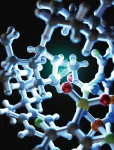(Press-News.org) (MEMPHIS, Tenn. – Oct. 10, 2024) Immunotherapy, using a patient’s own immune system to treat disease, has shown promise in some patients with cancer but has not worked in most. New research from St. Jude Children’s Research Hospital and colleagues found that disrupting Asxl1, a gene in T cells, improved sensitivity to a type of immunotherapy called immune checkpoint blockade and improved long-term tumor control in modes systems. The findings were published today in Science.
Cells of the immune system use “checkpoints” or signals that tell them how to react to diseased cells or pathogens. Tumors can hijack these checkpoints to turn the immune system off, helping the cancer cells hide and survive. Immune checkpoint inhibitors or blockades can stop tumors’ suppressive effects, helping the immune system find and kill cancer cells.
“We discovered that disrupting the Axsl1 gene in T cells resulted in a better response to immune checkpoint blockade,” said senior co-corresponding author Caitlin Zebley, MD, PhD, St. Jude Department of Bone Marrow Transplantation and Cellular Therapy.
T cells that encounter too many tumor cell pieces can also become exhausted and lose their ability to kill cancerous cells. The researchers showed that removing Asxl1 prevented T-cell exhaustion, enabling long-term immune responses.
“We found Asxl1 controls the epigenetic checkpoint that reinforces the terminal differentiation of T cells into the exhausted state. When the T cells differentiate past this checkpoint, they are rendered essentially useless for immunotherapy,” said co-corresponding author Ben Youngblood, PhD, St. Jude Department of Immunology. “Our discovery of this molecular checkpoint is a critical advancement for the field because it now allows us to further engineer T cells with a durable anti-tumor response.”
To make this finding required expertise in both immune cell signaling and immunotherapy, as well as samples from patients who had been successfully treated with immune checkpoint blockade, highlighting the importance of collaboration in scientific research.
“Immunotherapies have saved countless lives. Today’s findings demonstrate how epigenetics can further improve these powerful treatments to help even more people,” said co-author Peter A. Jones, PhD, D.Sc. (hon), Van Andel Institute president and chief scientific officer and Van Andel Institute–Stand Up To Cancer® Epigenetics Dream Team co-leader, which provided data on patients that had received immunotherapy. “We are thrilled to support this vital work, which underscores the immense power of collaboration as we tackle cancer together.”
Reverse engineering immunotherapy success
Immune checkpoint blockade has been highly effective and sometimes curative in a subset of cancer patients, with its discovery earning James P. Allison and Tasuku Honjo the 2018 Nobel Prize in Physiology or Medicine. But the approach does not work for all patients. Youngblood, Zebley, and their colleagues, therefore, examined the genetics of responders to figure out what is different about the biology of individuals who respond to immune checkpoint blockade.
“We looked at a small cohort of patients with myelodysplastic syndrome who had significantly improved long-term survival after treatment with a specific checkpoint inhibitor,” Zebley said. “We found ASXL1 mutated in the T cells of all of those patients and decided to investigate further.”
The researchers followed up by removing Asxl1 in mouse T cells. They found that during checkpoint blockade, the immune system in these mice was better able to control tumors, and for longer, compared to mice with Asxl1 intact. Further investigation revealed removing Asxl1 improved therapy by preserving a small group of T cells that avoided exhaustion and maintained their anticancer effect over a year.
“We showed Asxl1 disruption endows T cells with superior long-term therapeutic potential, which could be a promising strategy for the design of future T cell-based immunotherapies,” Zebley said.
Authors and funding
The study’s first author is Tae Gun Kang, of St. Jude. The study’s other authors are Xin Lan, Tian Mi, Hongfeng Chen, Shanta Alli, Anoop Babu Vasandan, Grace Ward, Peter Vogel and Christopher Derenzo; St. Jude; Song-Eun Lim, Sheetal Bhatara, Jiyang Yu and Xin Lan; University of Tennessee Health Science Center; Sofia Bentivegna, Jakob Schmidt Jespersen, Kirsten Grønbæk and Balthasar Clemens Schlotmann; Copenhagen University Hospital; Josh Jang; Van Andel Institute–Stand Up To Cancer®; Marianne Spatz and Jin-Hwan Han; Merck & Co. Inc.; Stephen Baylin; The Sidney Kimmel Comprehensive Cancer Institute at Johns Hopkins; Casey O’Connell; University of Southern California and Kirsten Grønbæk; University of Copenhagen.
The study was supported by grants from the National Institutes of Health (R01AI114442 and R01CA237311, K08CA279926-0 and R35CA209859), the National Comprehensive Cancer Network Young
Investigator Award, Alex Lemonade Stand Young Investigator Grant, Van Andel Research Institute - Stand Up To Cancer® Epigenetics Dream Team (Stand Up To Cancer is a division of the Entertainment Industry Foundation), ASSISI Foundation, Merck & Co. and ALSAC, the fundraising and awareness organization of St. Jude.
If you are interested in licensing the technology involved in this work (ASXL1 inhibition to improve T-cell immunotherapy SJ-22-0034) from St. Jude for further development and/or commercial use, find out more about licensing.
St. Jude Media Relations Contacts
Michael Sheffield
Desk: (901) 595-0221
Cell: (901) 379-6072
michael.sheffield@stjude.org
media@stjude.org
Rae Lyn Hartley
Cell: (901) 686-2597
raelyn.hartley@stjude.org
media@stjude.org
St. Jude Children's Research Hospital
St. Jude Children's Research Hospital is leading the way the world understands, treats and cures childhood cancer, sickle cell disease and other life-threatening disorders. It is the only National Cancer Institute-designated Comprehensive Cancer Center devoted solely to children. Treatments developed at St. Jude have helped push the overall childhood cancer survival rate from 20% to 80% since the hospital opened more than 60 years ago. St. Jude shares the breakthroughs it makes to help doctors and researchers at local hospitals and cancer centers around the world improve the quality of treatment and care for even more children. To learn more, visit stjude.org, read St. Jude Progress, a digital magazine, and follow St. Jude on social media at @stjuderesearch.
END
Disrupting Asxl1 gene prevents T-cell exhaustion, improving immunotherapy
Scientists at St. Jude Children’s Research Hospital and colleagues found that disrupting the Asxl1 gene improves tumor control during immune checkpoint blockade
2024-10-10
ELSE PRESS RELEASES FROM THIS DATE:
How your skin tone could affect your meds
2024-10-10
RIVERSIDE, Calif. -- Skin pigmentation may act as a “sponge” for some medications, potentially influencing the speed with which active drugs reach their intended targets, a pair of scientists report in a perspective article published in the journal Human Genomics.
The researchers argue that a sizable proportion of drugs and other compounds can bind to melanin pigments in the skin, leading to differences in how bioavailable and efficacious these drugs and other compounds are in people with varying skin tones.
“Our review paper concludes that melanin, the pigment responsible for skin color, shows a surprising affinity for certain drug compounds,” ...
NEC Society, Cincinnati Children's, and UNC Children’s announce NEC Symposium in Chicago
2024-10-10
The NEC Society, Cincinnati Children's, and UNC Children’s are proud to announce the NEC Symposium in Chicago, September 7 - 10, 2025. As the world’s largest conference focused on necrotizing enterocolitis (NEC), the NEC Symposium will bring together key stakeholders to unite the global community for a world without NEC.
The NEC Society has organized the NEC Symposium biennially since 2017, with the most recent 2023 NEC Symposium engaging over 200 participants from nine countries and 35 U.S. states. The 2025 NEC Symposium in Chicago will bring together 300 clinicians, scientists, patient-family advocates, ...
Extreme heat may substantially raise mortality risk for people experiencing homelessness
2024-10-10
FOR IMMEDIATE RELEASE
Thursday, October 10, 2024
Contact:
Jillian McKoy, jpmckoy@bu.edu
Michael Saunders, msaunder@bu.edu
##
By nature of their living situation, people experiencing homelessness (PEH) are considered one of the most vulnerable populations to the health impacts of extreme weather.
PEH are particularly vulnerable to heat, and the impact of heat on mortality in this group is substantially greater than for the general population, according to a new study by Boston University School of Public Health (BUSPH).
Published in the American Journal of Epidemiology, the study examined mortality rates in two hot-climate US counties—Clark ...
UTA professor earns NSF grants to study human-computer interaction
2024-10-10
Fillia Makedon, a Distinguished Professor in the Computer Science and Engineering Department at The University of Texas at Arlington, has been awarded two new National Science Foundation (NSF) grants involving human-computer interaction. In one, she will study extended reality to assess attention levels in people with attention deficit hyperactivity disorders (ADHD); in the other, she will look at how human-robot interaction could help visually impaired persons perform job duties remotely from home using telerobotic technologies.
The NSF awarded ...
How playing songs to Darwin’s finches helped UMass Amherst biologists confirm link between environment and the emergence of new species
2024-10-10
Embargoed: Not for Release Until 2:00 pm U.S. Eastern Time Thursday, 10 October 2024
October 10, 2024
AMHERST, Mass. – They say that hindsight is 20/20, and though the theory of ecological speciation — which holds that new species emerge in response to ecological changes — seems to hold in retrospect, it has been difficult to demonstrate experimentally, until now. In research recently published in Science, biologists from the University of Massachusetts Amherst have identified a key connection between ecology and speciation in Darwin’s finches, famous residents of the Galápagos Islands, Ecuador. Prior work on these birds ...
A holy grail found for catalytic alkane activation
2024-10-10
An organic catalyst offers chemists precise control over a vital step in activating hydrocarbons.
Researchers at Hokkaido University in Japan have made a significant breakthrough in organic chemistry by developing a novel method to activate alkanes, which are compounds that play a crucial role in the chemical industry. The new technique, published in Science, makes it easier to convert these building blocks into valuable compounds, offering advances in the production of medicines and cutting-edge materials.
Alkanes are a primary component of fossil fuels and are also vital building blocks in the production ...
Galápagos finches could be singing a different song after repeated drought—one that leads to speciation
2024-10-10
Galápagos finches use their beaks to crush seeds and sing songs, so what happens to their musical trills when their beaks change to respond to new menus available under drought? Jeffrey Podos and Katie Schroeder found that the song might not remain the same after six cumulative future drought events that would likely reshape the finch beak. The projected changes in male mating songs could be so significant that they provide a pathway for ecological speciation, the researchers suggest. The researchers tested this idea by digitally modifying ...
Hidden “tails” slow marine snow, impacting deep sea carbon transfer and storage
2024-10-10
Newly discovered microscopic mucus tails – trailing from particles of marine snow particles – slow these particles’ descent into the deep ocean, research finds. This doubles the particles’ residence time in the ocean's upper layers and significantly alters estimates of how much carbon is sequestered in the deep sea. The oceans serve as a vast reservoir and critical sink for atmospheric carbon dioxide. A key process driving carbon sequestration in the ocean is the biological pump, where photosynthetic activity ...
Seed dispersal “crisis” may impact plant species’ future in Europe
2024-10-10
Europe is facing a seed dispersal “crisis,” due to extinction threats and population changes among the animals that do the seed dispersing, according to a new synthesis by Sara Beatriz Mendes and colleagues. Their literature review of animal and plant dispersal pairs helped them reconstruct the first European-wide seed dispersal network. Seed dispersal by animals is a critical part of maintaining healthy ecosystems, especially in fragmented environments like those found throughout Europe. Lack of seed dispersal to connect populations could prevent declining plant populations from ...
Nitrogen deposition has shifted European forest plant ranges westward over decades
2024-10-10
Researchers have documented a shift in plant species ranges toward the poles or higher latitudes in the face of climate warming, but Pieter Sanczuk and colleagues now reveal another unexpected pattern of range shift. For decades, understory plants in European temperate forests have been on the move westward, spurred by differences in nitrogen deposition rates. Westward species distribution shifts were 2.6 times more likely than northward ones, according to the researchers, who also noted that forest canopy changes played a role in this shift as well. The findings suggest that factors beyond climate change, such as atmospheric pollution, are also an important part of redistributing biodiversity. ...
LAST 30 PRESS RELEASES:
Orthopedics can play critical role in identifying intimate partner violence
Worms as particle sweepers
Second spider-parasitic mite described in Brazil
January 2026 issues of APA journals feature new research on autism, pediatric anxiety, psychedelic therapy, suicide prevention and more
Private equity acquired more than 500 autism centers over the past decade, new study shows
New cervical cancer screening guidelines from the US Department of Health and Human Services
Estimated burden of COVID-19 illnesses, medical visits, hospitalizations, and deaths in the US from October 2022 to September 2024
Smartphone use during school hours by US youth
Food insecurity and adverse social conditions tied to increased risk of long COVID in children
Earliest, hottest galaxy cluster gas on record could change our cosmological models
Greenland’s Prudhoe Dome ice cap was completely gone only 7,000 years ago, first GreenDrill study finds
Scientific validity of blue zones longevity research confirmed
Injectable breast ‘implant’ offers alternative to traditional surgeries
Neuroscientists devise formulas to measure multilingualism
New prostate cancer trial seeks to reduce toxicity without sacrificing efficacy
Geometry shapes life
A CRISPR screen reveals many previously unrecognized genes required for brain development and a new neurodevelopmental disorder
Hot flush treatment has anti-breast cancer activity, study finds
Securing AI systems against growing cybersecurity threats
Longest observation of an active solar region
Why nail-biting, procrastination and other self-sabotaging behaviors are rooted in survival instincts
Regional variations in mechanical properties of porcine leptomeninges
Artificial empathy in therapy and healthcare: advancements in interpersonal interaction technologies
Why some brains switch gears more efficiently than others
UVA’s Jundong Li wins ICDM’S 2025 Tao Li Award for data mining, machine learning
UVA’s low-power, high-performance computer power player Mircea Stan earns National Academy of Inventors fellowship
Not playing by the rules: USU researcher explores filamentous algae dynamics in rivers
Do our body clocks influence our risk of dementia?
Anthropologists offer new evidence of bipedalism in long-debated fossil discovery
Safer receipt paper from wood
[Press-News.org] Disrupting Asxl1 gene prevents T-cell exhaustion, improving immunotherapyScientists at St. Jude Children’s Research Hospital and colleagues found that disrupting the Asxl1 gene improves tumor control during immune checkpoint blockade





